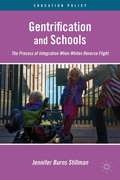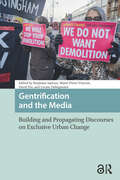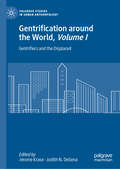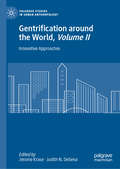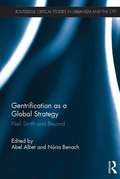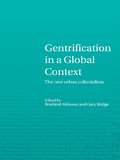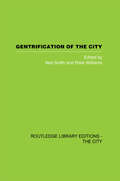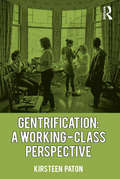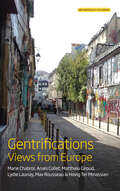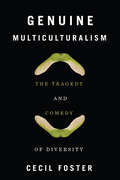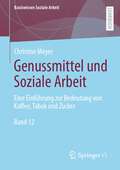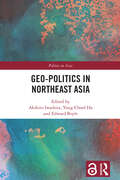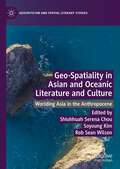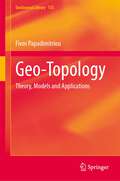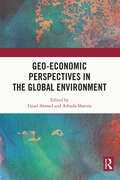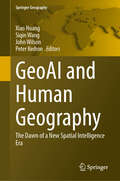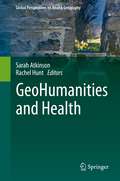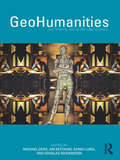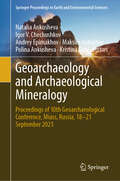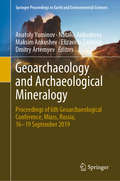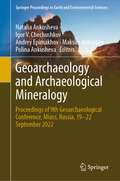- Table View
- List View
Gentrification and Schools
by Jennifer Burns StillmanThrough fifty-two interviews with New York City parents in gentrifying neighborhoods, this book examines the school choice process to determine how, through the compounding effect of these parents' many individual choices, a segregated urban school in a gentrifying neighborhood is able to transform into an integrated school.
Gentrification and the Media: Building and Propagating Discourses on Exclusive Urban Change (Cities and Cultures)
by Louise Dalingwater David Fée Stéphane Sadoux Marie-Pierre VincentGentrification is extensively discussed in the media, where coverage can describe changing neighbourhoods and analyse the causes and consequences of such change. The media are also arenas in which the voices of those who advocate or resist gentrification can be heard. How can this profusion of content be examined? What methods can be used to critically address the role of the media in constructing and propagating discourses on gentrification? Central to this book is the idea that new research should engage with the theoretical and methodological issues that emerge when media products are used as a corpus to study gentrification.
Gentrification around the World, Volume I: Gentrifiers and the Displaced (Palgrave Studies in Urban Anthropology)
by Jerome Krase Judith N. DeSenaBringing together scholarly but readable essays on the process of gentrification, this two-volume collection addresses the broad question: In what ways does gentrification affect cities, neighborhoods, and the everyday experiences of ordinary people? In this first volume of Gentrification around the World, contributors from various academic disciplines provide individual case studies on gentrification and displacement from around the globe: chapters cover the United States of America, Spain, Brazil, Sweden, Japan, Korea, Morocco, Great Britain, Canada, France, Finland, Peru, India, Indonesia, Pakistan, Syria, and Iceland. The qualitative methodologies used in each chapter—which emphasize ethnographic, participatory, and visual approaches that interrogate the representation of gentrification in the arts, film, and other mass media—are themselves a unique and pioneering way of studying gentrification and its consequences worldwide.
Gentrification around the World, Volume II: Innovative Approaches (Palgrave Studies in Urban Anthropology)
by Jerome Krase Judith N. DeSenaBringing together scholarly but readable essays on the process of gentrification, this two-volume collection addresses the broad question: In what ways does gentrification affect cities, neighborhoods, and the everyday experiences of ordinary people? In this second volume of Gentrification around the World, contributors contemplate different ways of thinking about gentrification and displacement in the abstract and “on-the-ground.” Chapters examine, among other topics, social class, development, im/migration, housing, race relations, political economy, power dynamics, inequality, displacement, social segregation, homogenization, urban policy, planning, and design. The qualitative methodologies used in each chapter—which emphasize ethnographic, participatory, and visual approaches that interrogate the representation of gentrification in the arts, film, and other mass media—are themselves a unique and pioneering way of studying gentrification and its consequences worldwide.
Gentrification as a Global Strategy: Neil Smith and Beyond (Routledge Critical Studies in Urbanism and the City)
by Abel Albet Núria BenachThis book pays homage to Neil Smith’s ideas, offering a critical approach and rich collection of insights that draw on Smith’s work for inspiration and debate. With interdisciplinary and international contributions from leading experts, the book demonstrates the impact of Smith’s ideas on understanding the role of urbanisation in general and gentrification, in particular, in contemporary society. The book demonstrates how gentrification varies significantly from city to city, across different cultural and political-economic regimes, and in terms of the timing of urban transformations. This collection provides a forum for debate for those working in urban regeneration and citizenship, and those directly affected by the processes and problems arising from gentrification. It will be of interest to students and scholars in urban geography, urban sociology, cultural studies, and wider social and urban theories.
Gentrification in Chinese Cities: State Institutions, Space and Society (Urban Sustainability)
by Qinran YangThis book provides an institutional interpretation of state-facilitated gentrification in Chengdu, an emerging central city of China. It generalizes the three aspects of institutional changes in the cultural, economic and social spheres that have thus far directed the operation of gentrification in the transitional economy: the creative destruction of consumption spaces, the spatial production of excess, and the unequal redistribution of spatial resources to low-income residents. The interactions of state and society, are examined in navigating the institutional changes and forming the Chinese distinctions of gentrification. The author argues that these three aspects of institutional changes characterize gentrification in Chengdu as a transformative force of development led by the state and capitalists and championed by middle-class consumers. This gentrification mode periodically catalyzes new spaces and collective cultures, which then necessitate the stimulation of new consumption behaviors and the formation of new consumer classes, at the expense of the spatial demands for the even larger number of low-income residents. However, in the context of China's unique state–society relations, some low-income groups may also ride the wave of social transformation. The author suggests that this type of gentrification integrates into not the essence of uneven geographical development in a capitalist society, but China’s unique model of urbanization and development, which is often state-driven, innovative and even involuted so as to sustain continuous growth. Though the research is focused on urban China, this book also contributes to methodological issues on gentrification research on a global scale. It is skeptical both of the structural explanation and of the revelation of unsorted differences; instead, it aims to generate midrange regularities of gentrification in Chinese cities. Institutional change is treated as an intermediary that, on the one hand, responds to the global trends and, on the other hand, adapts to local preconditions. Mixed methods, including statistical and spatial analysis, institutional analysis, and an extensive ethnographic study, are used to investigate gentrification from a structural perspective, a historical perspective, and as a grounded process within the locality.
Gentrification in a Global Context: The New Urban Colonialism (Housing and Society Series)
by Gary Bridge Rowland AtkinsonGentrification, a process of class neighbourhood upgrading, is being identified in a broader range of urban contexts throughout the world. This book throws new light and evidence to bear on a subject that deeply divides commentators on its worth and social costs given its ability to physically improve areas but also to displace indigenous inhabitants.Gentrification in a Global Perspective brings together the most recent theoretical and empirical research on gentrification at a global scale. Each author gives an overview of gentrification in their country so that each chapter retains a unique approach but tackles a common theme within a shared framework. The main feature of the book is a critical and well-written set of chapters on a process that is currently undergoing a resurgence of interest and one that shows no sign of abating.
Gentrification is Inevitable and Other Lies
by Leslie KernHow Gentrification is killing our cities, and what we can do about itWhat does gentrification look like? Can we even agree that it is a process that replaces one community with another? It is a question of class? Or of economic opportunity? Who does it affect the most? Is there any way to combat it? Leslie Kern, author of the best selling Feminist City, travels from Toronto, New York, London, Paris and San Francisco and scrutinises the myth and lies that surround this most urgent urban crisis of our times.First observed in 1950s London, and theorised by leading thinkers such as Ruth Glass, Jane Jacobs and Sharon Zukin, this devastating process of displacement now can be found in every city and most neighbourhoods. Beyond the Yoga studio, farmer's market and tattoo parlour, gentrification is more than a metaphor, but impacts the most vulnerable communities. Kern proposes an intersectional way at looking at the crisis that seek to reveal the violence based on class, race, gender and sexuality. She argues that gentrification is not natural That it can not be understood in economics terms, or by class. That it is not a question of taste. That it can only be measured only by the physical displacement of certain people. Rather, she argues, it is an continuation of the setter colonial project that removed natives from their land. And it can be seen today is rising rents and evictions, transformed retail areas, increased policing and broken communities.But if gentrification is not inevitable, what can we do to stop the tide? In response, Kern proposes a genuinely decolonial, feminist, queer, anti-gentrification. One that demands the right to the city for everyone and the return of land and reparations for those who have been displaced.
Gentrification: A Working-class Perspective
by Kirsteen PatonFocusing on the working-class experience of gentrification, this book re-examines the enduring relationship between class and the urban. Class is so clearly articulated in the urban, from the housing crisis to the London Riots to the evocation of housing estates as the emblem of ’Broken Britain’. Gentrification is often presented to a moral and market antidote to such urban ills: deeply institutionalised as regeneration and targeted at areas which have suffered from disinvestment or are defined by ’lack’. Gentrification is no longer a peripheral neighbourhood process: it is policy; it is widespread; it is everyday. Yet comparative to this depth and breadth, we know little about what it is like to live with gentrification at the everyday level. Sociological studies have focused on lifestyles of the middle classes and the working-class experience is either omitted or they are assumed to be victims. Hitherto, this is all that has been offered. This book engages with these issues and reconnects class and the urban through an ethnographically detailed analysis of a neighbourhood undergoing gentrification which historicises class formation, critiques policy processes and offers a new sociological insight into gentrification from the perspective of working-class residents. This ethnography of everyday working-class neighbourhood life in the UK serves to challenge denigrated depictions which are used to justify the use of gentrification-based restructuring. By exploring the relationship between urban processes and working-class communities via gentrification, it reveals the ’hidden rewards’ as well as the ’hidden injuries’ of class in post-industrial neighbourhoods. In doing so, it provides a comprehensive ’sociology of gentrification’, revealing not only how gentrification leads to the displacement of the working class in physical terms but how it is actively used within urban policy to culturally displace the working-class subject and traditional
Gentrifications: Views from Europe (Anthropology of Europe #7)
by Lydie Launay Marie Chabrol Anaïs Collet Matthieu GiroudOffering an original discussion of the gentrification phenomenon in Europe, this book provides new theoretical insights into classical works on the subject. Using a thorough analysis of the diversity of the forms, places and actors of gentrification in an attempt to isolate its ‘DNA’, the book addresses the place of social groups in cities, their competition over the appropriation of space, the infrastructure unequally offered to them by economic and political actors and the stakes of everyday social relationships.
Genuine Multiculturalism: The Tragedy and Comedy of Diversity
by Cecil FosterWhile many modern societies are noted for their diversity, the resulting challenge is to determine how citizens from different backgrounds and cultures can see themselves and each other as equals, and be treated equally. In Genuine Multiculturalism, Cecil Foster shows that a society's failure to bridge these differences is the tragedy of modern living and that pretending it is possible to mechanically develop fraternity and solidarity among diverse groups is akin to seeking out comedy. Arguing that genuine multiculturalism is the search for social justice by individuals who have been trapped by ascribed identities or newcomers who have been shut out of perceived ethnic homelands, Foster details how this process, in essence, is the story of the Americas. Reconceptionalizing the terms of multiculturalism, he offers an intervention into Canada's claim that its definition and practice are based on recognizing equality of citizenship. Identifying genuine multiculturalism as an ongoing work in progress, rather than a tightly defined policy position, Foster challenges readers to imagine a greater and more harmonious ideal. A necessary theoretical reconsideration of diversity within society, Genuine Multiculturalism refocuses the debate about ideals and practices in modern societies.
Genussmittel und Soziale Arbeit: Eine Einführung zur Bedeutung von Kaffee, Tabak und Zucker (Basiswissen Soziale Arbeit #12)
by Christine MeyerDas Lehrbuch bietet einen Einstieg in Fragen rund um drei für Soziale Arbeit bedeutende Genussmittel: Kaffee, Tabak und Zucker. Fachkräfte der Sozialen Arbeit sind wiederkehrend in ganz verschiedenen Perspektiven mit ihrem Konsum befasst. Neben gesundheitsbezogenen Fragen aufgrund der gesellschaftlichen Ächtung von (zu viel) Zucker und Tabak lassen sich an ihnen bedeutende sozialpädagogische Fragen aufmachen, die jenseits gesundheitsbezogener, z. B. Fragen der Gastlichkeit, der Gestaltung professionell angenehmer Atmosphären, der Verteilung sowie des offenen Zugangs betreffen. In nahezu jedem sozialpädagogischen Setting werden täglich Verzehrsituationen bzw. Mahlzeiten geplant, angeboten und durchgeführt. Für die Soziale Arbeit über die Bereitstellung ausreichender und ausgewogener Ernährung hinaus verantwortlich ist für die Bereitstellung von Genussmitteln und deren Konsum vor dem Hintergrund gesellschaftlich relevanter eingelebter Kulturen und Traditionen. Das Lehrbuch ermöglicht, über den Gesamtzusammenhang von Genussmitteln im Zusammenhang mit Ernährung als grundlegende und voraussetzungsvolle Bedingungen sozialpädagogischen Denkens und Handelns reflektieren zu können. In allen Handlungsfeldern der Sozialen Arbeit sind Genussmittel auf unterschiedlichen Ebenen und mit verschiedenen Funktionen wiederkehrend Thema und können als täglich zu bewältigende Herausforderung eingeschätzt werden. Diese grundlegende Einführung ermöglicht eine Bewusstmachung und damit auch fachliche Reflexionsmöglichkeiten für den individuellen und gesellschaftlich verantwortlichen sozialpädagogischen Umgang von Fachkräften mit Fragen rund um die insbesondere für Soziale Arbeit bedeutenden Genussmittel Kaffee, Tabak und Zucker.
Geo-Politics in Northeast Asia (Politics in Asia)
by Akihiro Iwashita Yong-Chool Ha Edward BoyleGeo-Politics in Northeast Asia focuses on the dynamics of Northeast Asia as a region. The chapters in this book offer a nuanced approach for understanding the geo-politics of this strategically critical area of the world. Focusing on China, Japan, Russia, and the Koreas, as well as the involvement of the United States, the contributors to the volume offer a timely and critical analysis of Northeast Asia. They collectively emphasize the different scales at which the region holds significance, and particularly note how the region is often granted significance by local political forces as well as national interests. Borderlands and sub-regions are especially important in this perspective, and the contributors show both how regionalism influences the people living in these areas and how they in turn shape the political priorities of states. At the same time, the worsening of relations between Japan and the Koreas and the increasing assertiveness of both China and Russia make it essential to understand the dynamics of the region, as well as how they have changed during and following the Trump era. Geo-Politics in Northeast Asia is essential reading for students and scholars of Political Geography, International Relations and Strategic Studies, as well as for those with a research focus on Northeast Asia, or the wider Asia-Pacific and Indo-Pacific regions.
Geo-Spatiality in Asian and Oceanic Literature and Culture: Worlding Asia in the Anthropocene (Geocriticism and Spatial Literary Studies)
by Soyoung Kim Shiuhhuah Serena Chou Rob Sean WilsonThis collection opens the geospatiality of “Asia” into an environmental framework called "Oceania" and pushes this complex regional multiplicity towards modes of trans-local solidarity, planetary consciousness, multi-sited decentering, and world belonging. At the transdisciplinary core of this “worlding” process lies the multiple spatial and temporal dynamics of an environmental eco-poetics, articulated via thinking and creating both with and beyond the Pacific and Asia imaginary.
Geo-Topology: Theory, Models and Applications (GeoJournal Library #133)
by Fivos PapadimitrouGeo-Topology is an exploration of the depth and breadth of the relationships between Geography and Topology, with applications ranging from Landscape Geography to Social Geography and from Spatial Analysis to Geospatial Technologies. It shows how topics of geographical research (landscapes, borders, spatial social relationships etc) can be examined by using mathematical concepts and methods of Topology, exposing the realm of geo-topological modelling and visualization through Point-Set Topology, Knot Theory, Reeb graphs, Topological Surfaces (i.e. Möbius bands and Klein bottles), Differential Topology, Network Analysis, Combinatorial Topology, Braid Theory and Ultrametric Topology. Besides geographers, this book is a trove of new ideas for landscape ecologists, mathematicians, data scientists, sociologists, psychologists, anthropologists and educators. Geo-Topology is a systematic introduction to topological thinking in Geography, also by highlighting the significance of Topology for Geographical Education, as well as for the Philosophy and Epistemology of Geography.
Geo-economic Perspectives in the Global Environment
by Faisal Ahmed Arbuda SharmaThe Covid-19 pandemic brought about significant changes in the world order. It not only reshaped the global geopolitical architecture but also created newer challenges and opportunities for international trade and businesses. This book deliberates on these new global realities through a multidisciplinary perspective. It delves into various key issues pertaining to finance, infrastructure, policy, geostrategy, and entrepreneurship in the Indian context. The volume discusses themes such as geostrategic shifts and their impact on the Indo-Pacific region, the effects of Covid-19 on international and economic security, India-China bilateral ties, FDI spill over on domestic firms, entrepreneurship education in India, and the Thai Canal project. Rich in insights on various geo-economic perspectives that continue to shape the global business environment, the book will be useful for students and scholars of sociology, business management, business economics, international trade, geopolitics, international relations, political sociology, and political studies. It will serve as a useful reference for academics, researchers, think tanks, industry professionals, and policymakers.
GeoAI and Human Geography: The Dawn of a New Spatial Intelligence Era (Springer Geography)
by John Wilson Xiao Huang Siqin Wang Peter KedronThis volume outlines a comprehensive journey into how geospatial artificial intelligence (GeoAI) is reshaping our understanding of people and places. Merging traditional geographic inquiry with AI technologies, it offers a holistic view of digital tools and advanced algorithms that redefine human geography. Across twenty‐eight chapters, the book chronicles the evolution of geographic thought into the GeoAI era. Innovative methodologies—from explainable spatial analysis and natural language processing to human-centered computer vision and high-performance computing—reveal new patterns and relationships beyond conventional approaches. Each contribution highlights both technical strides in data processing and enriched perspectives on cultural, economic, political, health, and urban studies. Showcasing diverse applications in disaster management, climate change adaptation, and urban planning, the volume demonstrates GeoAI&’s transformative potential. It also engages with ethical, sustainable, and social challenges, emphasizing that technological innovation must serve real-world impacts and inclusivity. Ideal for researchers, students, and practitioners alike, this volume invites you to explore new frontiers at the intersection of technology and human experience.
GeoHumanities and Health (Global Perspectives on Health Geography)
by Sarah Atkinson Rachel HuntThis volume brings together research in the GeoHumanities from various intellectual perspectives to illustrate the benefits of humanities-inspired approaches in understanding and confronting historically entrenched and recently emergent health-related challenges. In three main sections, this volume seeks to foreground the richness of work entangling medicine and health with the concerns of geography and of the Humanities. This volume will be of interest to academics and researchers in the Geographies of health and medicine, social sciences in GeoHumanities, and health humanities, and students in programs focusing on the humanities and health. In the book's first section, Bodies, the authors explore the material, sensory and more than physical capacities of bodies in accounting for experiences of death, air raids, immigration, dance therapy, asthma and blindness. Section two, Voice, addresses the nature of evidence, HIV/AIDS policy, patient voices in animal research, homelessness, and constructions of truth. The final section, Practice, focuses on creative writing, as well as the pedagogic tools of teaching with the asylum, the creative practice of nuclear emergency planning zones, arts-based care for the elderly, and cartographic practices within health research.
GeoHumanities: Art, History, Text at the Edge of Place
by Douglas Richardson Michael Dear Jim Ketchum Sarah LuriaIn the past decade, there has been a convergence of transdisciplinary thought characterized by geography’s engagement with the humanities, and the humanities’ integration of place and the tools of geography into its studies. GeoHumanities maps this emerging intellectual terrain with thirty cutting edge contributions from internationally renowned scholars, architects, artists, activists, and scientists. This book explores the humanities’ rapidly expanding engagement with geography, and the multi-methodological inquiries that analyze the meanings of place, and then reconstructs those meanings to provoke new knowledge as well as the possibility of altered political practices. It is no coincidence that the geohumanities are forcefully emerging at a time of immense intellectual and social change. This book focuses on a range of topics to address urgent contemporary imperatives, such as the link between creativity and place; altered practices of spatial literacy; the increasing complexity of visual representation in art, culture, and science and the ubiquitous presence of geospatial technologies in the Information Age. GeoHumanties is essential reading for students wishing to understand the intellectual trends and forces driving scholarship and research at the intersections of geography and the humanities disciplines. These trends hold far-reaching implications for future work in these disciplines, and for understanding the changes gripping our societies and our globalizing world.
Geoarchaeology and Archaeological Mineralogy: Proceedings of 10th Geoarchaeological Conference, Miass, Russia, 18–21 September 2023 (Springer Proceedings in Earth and Environmental Sciences)
by Natalia Ankusheva Maksim Ankushev Igor V. Chechushkov Polina Ankusheva Andrey V. Epimakhov Kristina ŠarićThe volume of Springer Proceedings in Geoarchaeology and Archaeological Mineralogy contains selected papers presented at the 10th Geoarchaeology Conference, which took place during September 18–21, 2023, at the South Urals Federal Research Center, the Ural Branch of the Russian Academy of Sciences, Miass, Russia. The Proceedings unite studies in the fields of archaeometry, geoarchaeology, and ancient technologies, based on cases from northern Eurasia, and include archaeometallurgy, stone tools investigation, exploitation of geological resources in the past, bioarchaeology, residue analysis, pottery and lithics investigation, use of the GIS in archaeology. A study of non-organic materials, rocks, minerals, ores, metals, metallurgical slags is a special focus of the book. Many papers also use modern analytical methods of isotopic, chemical, and mineralogical analysis to study the composition and structure of ancient materials and the technological practices of past human populations of Modern Russia, Caucasus, and Serbia. The volume is intended for archaeologists, historians, museum staff, and geologists, as well as students, researchers from other disciplines, and the general public interested in the interdisciplinary research in the field of archaeology and archaeological materials, strategies and techniques of past quarrying, mining, metallurgy and lithic technologies at different chronological periods in Northern Eurasia.
Geoarchaeology and Archaeological Mineralogy: Proceedings of 6th Geoarchaeological Conference, Miass, Russia, 16–19 September 2019 (Springer Proceedings in Earth and Environmental Sciences)
by Anatoly Yuminov Natalia Ankusheva Maksim Ankushev Elizaveta Zaykova Dmitry ArtemyevThis book presents general problems in geoarchaeology, and discusses geophysical solutions, X-ray fluorescence spectrometry applications, X-ray and isotope analyses and GIS technologies. It also examines practical reconstructions of technological processes used in ancient time, and investigates the use of minerals and rocks by ancient societies in the territories of modern Russia, Ukraine, Turkmenistan, and Tajikistan, as well as the characteristics of ores, metallurgical slags and data on the composition and impurities of archaeological metals. Intended for archaeologists, historians, museum workers and geologists studying noble metals and copper, the book is also a useful resource for students, graduate students, experts and anyone interested in the use of various minerals at different stages of humanity’s development.
Geoarchaeology and Archaeological Mineralogy: Proceedings of 7th Geoarchaeological Conference, Miass, Russia, 19–23 October 2020 (Springer Proceedings in Earth and Environmental Sciences)
by Natalia Ankusheva Maksim Ankushev Igor V. Chechushkov Ivan Stepanov Polina AnkushevaThis book of Springer Proceedings in Geoarchaeology and Archaeological Mineralogy contains selected papers presented at the 7th Geoarchaeology Conference, which took place during October 19–23, 2020, at the South Urals Federal Research Center, Ural Branch of Russian Academy of Sciences, Miass, Russia. The Proceedings combine studies in archeometry, geoarchaeology, and ancient North Eurasian technologies, including paleometallurgy, stone tools investigation, past exploitation of geological resources, bioarchaeology, residue analysis, pottery, and lithics studies. This book also specializes in various non-organic materials, rocks, minerals, ores, and metals, especially copper and metallurgical slags. Many types of research also use modern analytical methods of isotopic, chemical, and mineralogical analysis to address the composition and structure of ancient materials and the technological practices of past human populations of modern Russia, Ukraine, Turkmenistan, Tajikistan, and Mongolia. This book is intended for archaeologists, historians, museum workers, and geologists, as well as students, researchers from other disciplines, and the general public interested in the interdisciplinary research in the field of archaeology and archaeological materials, strategies and techniques of past quarrying, mining, metallurgy and lithic technologies at different chronological periods in Eurasian steppe and adjacent forest zone.
Geoarchaeology and Archaeological Mineralogy: Proceedings of 9th Geoarchaeological Conference, Miass, Russia, 19–22 September 2022 (Springer Proceedings in Earth and Environmental Sciences)
by Natalia Ankusheva Maksim Ankushev Igor V. Chechushkov Polina Ankusheva Andrey EpimakhovThe volume of Springer Proceedings in Geoarchaeology and Archaeological Mineralogy contains selected papers presented at the 9th Geoarchaeology Conference, which took place during September 19–22, 2022, at the South Urals Federal Research Center, the Ural Branch of the Russian Academy of Sciences, Miass, Russia. The Proceedings unite studies in the fields of archeometry, geoarchaeology, and ancient technologies, based on cases from northern Eurasia, and include archaeometallurgy, stone tools investigation, exploitation of geological resources in the past, bioarchaeology, residue analysis, pottery and lithics investigation, use of the GIS in archaeology. A study of non-organic materials, rocks, minerals, ores, metals, metallurgical slags is a special focus of the book. Many papers also use modern analytical methods of isotopic, chemical, and mineralogical analysis to study the composition and structure of ancient materials and the technological practices of past human populations of Modern Russia, Ukraine, Turkmenistan, Tajikistan, and Mongolia. The volume is intended for archaeologists, historians, museum workers, and geologists, as well as students, researchers from other disciplines, and the general public interested in the interdisciplinary research in the field of archaeology and archaeological materials, strategies and techniques of past quarrying, mining, metallurgy and lithic technologies at different chronological periods in Eurasian steppe and adjacent forest zone.
Geoarchaeology and Archaeological Mineralogy—2021: Proceedings of 8th Geoarchaeological Conference, Miass, Russia, 20–23 September 2021 (Springer Proceedings in Earth and Environmental Sciences)
by Igor V. Chechushkov Natalia N. Ankusheva Andrey V. Epimakhov Maksim N. Ankushev Polina S. AnkushevaThis book unites studies in the fields of archaeometry, geoarchaeology, and ancient technologies, based on cases from northern Eurasia, and includes archaeometallurgy, stone tools investigation, exploitation of geological resources in the past, bioarchaeology, residue analysis, pottery and lithics investigation, and use of the GIS in archaeology. The book of Springer Proceedings in Geoarchaeology and Archaeological Mineralogy contains selected papers presented at the 8th Geoarchaeology Conference, which took place during September 20–23, 2021, at the South Urals Federal Research Center, the Ural Branch of the Russian Academy of Sciences, Miass, Russia. A study of non-organic materials, rocks, minerals, ores, metals and metallurgical slags is a special focus of the book. Many papers also use modern analytical methods of isotopic, chemical, and mineralogical analysis to study the composition and structure of ancient materials and the technological practices of past human populations of Modern Russia, Ukraine, Turkmenistan, Tajikistan and Mongolia. The book is intended for archaeologists, historians, museum workers and geologists, as well as students, researchers from other disciplines and the general public interested in the interdisciplinary research in the field of archaeology and archaeological materials, strategies and techniques of past quarrying, mining, metallurgy and lithic technologies at different chronological periods in Eurasian steppe and adjacent forest zone.
